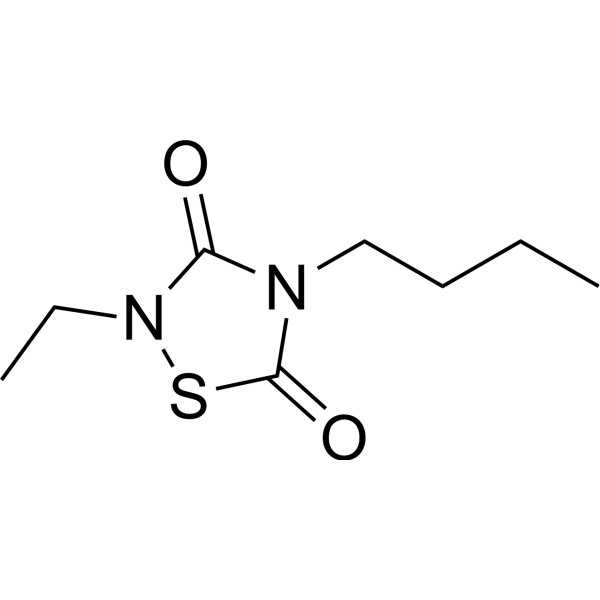CCG 203769,99.62%
产品编号:Bellancom-U00431| CAS NO:410074-60-1| 分子式:C8H14N2O2S| 分子量:202.27
本网站销售的所有产品仅用于工业应用或者科学研究等非医疗目的,不可用于人类或动物的临床诊断或者治疗,非药用,非食用,
CCG 203769
| 产品介绍 | CCG 203769 是一种选择性的 G 蛋白信号调节因子 (RGS4) 抑制剂,CCG 203769 阻断 RGS4-Gαo 蛋白-蛋白相互作用,IC50 为 17 nM。 | ||||||||||||||||
|---|---|---|---|---|---|---|---|---|---|---|---|---|---|---|---|---|---|
| 生物活性 | CCG 203769 is a selective G protein signaling (RGS4) inhibitor, which blocks the RGS4-Gαo protein-protein interaction in vitro with an IC50 of 17 nM. | ||||||||||||||||
| 体外研究 |
CCG 203769 also displays dramatic selectivity (8- to >5000-fold) for RGS4 over other RGS proteins. CCG 203769 inhibits RGS19 with an IC50 of 140 nM (8-fold selective for RGS4) and 6 μM for RGS16 (350-fold selective for RGS4). The closely related RGS8 is very weakly inhibited (IC50>60 μM) providing >4500-fold selectivity for RGS4. CCG 203769 inhibits GSK-3β with an IC50 value of 5 μM. CCG 203769 does not inhibit the cysteine protease papain at 100 μM. CCG 203769 does not inhibit RGS7, which lacks cysteines in the RGS domain. CCG 203769 inhibits RGS/Gαo binding in an RGS-selective manner. CCG 203769 enhances Gαq-dependent cellular Ca2+ signaling in an RGS4-dependent manner. CCG 203769 also blocks the GTPase accelerating protein (GAP) activity of RGS4. In single-turnover and steady-state GTPase experiments with Gαo and Gαi1, the rate of GTP hydrolysis is strongly stimulated by RGS4, and this effect is inhibited by CCG 203769 with an IC50<1 μM. 西域 has not independently confirmed the accuracy of these methods. They are for reference only. | ||||||||||||||||
| 体内研究 |
To determine whether this genetic disruption of RGS4 function can be replicated pharmacologically, CCG 203769 is tested for effects on Carbamoylcholine chloride-mediated bradycardia in conscious, unrestrained rats. Carbamoylcholine chloride (0.1 mg/kg, IP) produces a modest decrease in heart rate compared to that of a saline vehicle control. CCG 203769 (10 mg/kg, IV) has no significant effect upon heart rate when given alone. However, CCG 203769, administered immediately prior to Carbamoylcholine chloride, significantly potentiates the bradycardic effect (p < 0.05). Given the functional role of RGS4 in Parkinson’s disease models, CCG 203769 is tested in a pharmacologic model of D2 antagonist-induced bradykinesia. Raclopride administration in rats causes increased hang time in the bar test, which is rapidly reversed by doses of CCG 203769 ranging from 0.1 to 10 mg/kg. The lowest dose, 0.01 mg/kg has no effect, while 0.1 mg/kg produces a submaximal effect. The higher doses, 1 and 10 mg/kg, produce equivalent effects. Similarly, the raclopride-induced paw drag in mice is reversed by 0.1-10 mg/kg CCG 203769. 西域 has not independently confirmed the accuracy of these methods. They are for reference only. | ||||||||||||||||
| 体内研究 |
To determine whether this genetic disruption of RGS4 function can be replicated pharmacologically, CCG 203769 is tested for effects on Carbamoylcholine chloride-mediated bradycardia in conscious, unrestrained rats. Carbamoylcholine chloride (0.1 mg/kg, IP) produces a modest decrease in heart rate compared to that of a saline vehicle control. CCG 203769 (10 mg/kg, IV) has no significant effect upon heart rate when given alone. However, CCG 203769, administered immediately prior to Carbamoylcholine chloride, significantly potentiates the bradycardic effect (p < 0.05). Given the functional role of RGS4 in Parkinson’s disease models, CCG 203769 is tested in a pharmacologic model of D2 antagonist-induced bradykinesia. Raclopride administration in rats causes increased hang time in the bar test, which is rapidly reversed by doses of CCG 203769 ranging from 0.1 to 10 mg/kg. The lowest dose, 0.01 mg/kg has no effect, while 0.1 mg/kg produces a submaximal effect. The higher doses, 1 and 10 mg/kg, produce equivalent effects. Similarly, the raclopride-induced paw drag in mice is reversed by 0.1-10 mg/kg CCG 203769. 西域 has not independently confirmed the accuracy of these methods. They are for reference only. | ||||||||||||||||
| 性状 | Liquid | ||||||||||||||||
| 溶解性数据 |
In Vitro:
DMSO : 62.5 mg/mL (308.99 mM; Need ultrasonic) 配制储备液
*
请根据产品在不同溶剂中的溶解度选择合适的溶剂配制储备液;一旦配成溶液,请分装保存,避免反复冻融造成的产品失效。 In Vivo:
请根据您的实验动物和给药方式选择适当的溶解方案。以下溶解方案都请先按照 In Vitro 方式配制澄清的储备液,再依次添加助溶剂:
——为保证实验结果的可靠性,澄清的储备液可以根据储存条件,适当保存;体内实验的工作液,建议您现用现配,当天使用;
以下溶剂前显示的百
| ||||||||||||||||
| 运输条件 | Room temperature in continental US; may vary elsewhere. | ||||||||||||||||
| 储存方式 |
| ||||||||||||||||
| 参考文献 |








 浙公网安备 33010802013016号
浙公网安备 33010802013016号